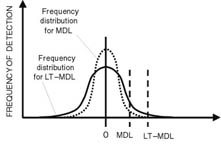
THE U.S. GEOLOGICAL SURVEY’S NEW REPORTING PROCEDURE
BASED ON LONG-TERM METHOD DETECTION LEVELS
A team was formed at the NWQL and included District and Office of Water Quality
representation. The mission of this team was to address the limitations of the
USEPA MDL procedure in relation to its use at the NWQL and to recommend an alternative
for determining method detection levels and setting reporting conventions.
The MDL team recommended a new approach—the long-term method detection level
(LT–MDL)— for the determination of an MDL that is based on a modification of
the USEPA MDL procedure. The LT–MDL is designed to capture greater method variability
because it
- Requires a larger number of replicate spike samples—at least 24 per year;
- Requires data collection over an extended period of time—typically 6 to 12 months;
and
- Incorporates more of the measurement variability that is typical for routine
analyses in a production laboratory, such as multiple instruments, operators,
calibrations, and sample preparation events.
Because this approach is designed to measure more sources of variability,
the LT–MDL is expected to be higher than the MDL obtained by using the USEPA
procedure (fig. 7). Although the procedure for determining the LT–MDL captures
a more representative measure of method variability, including blank contributions
to the variability, it still relies on several key assumptions underlying the
USEPA MDL procedure, including
- Normal frequency distribution,
- Constant standard deviation, and
- Best-case detection condition because LT–MDL’s typically are determined
by using spikes in a clean matrix, for example, reagent water.
 |
image size 16KB-jpg
Figure 7.
The long–term method detection level (LT–MDL) compared to the method
detection limit (MDL) determined by the U.S. Environmental Protection
Agency procedure.
|
At the LT–MDL concentration, the chance of a false positive detection is statistically
limited to <1 percent. At concentrations less than the LT–MDL, the risk
of false positive detections can increase rapidly. Therefore, for all inorganic
and many organic methods, the LT–MDL concentration is the lowest concentration
that will be reported by the NWQL, along with an estimated “E” remark code, for
a qualitatively detected analyte. Mass spectrometric or photodiode array ultraviolet/visible
spectroscopic detectors used for organic methods are classified by the NWQL as
“information-rich” methods because they have enhanced analyte identification capabilities.
For these methods, the NWQL will report values below the LT–MDL, along with an
estimated “E” remark code, because the criteria for identification must be met
before quantitative results are reported (see “New Reporting Conventions” section).
Although information-rich methods provide enhanced analyte identification capabilities,
concentrations reported below the LT–MDL still have an increased risk (>1 percent)
of being a false positive. Comparison of sample data relative to field and laboratory
blank data is a critical quality-control step when interpreting data, and is particularly
important when evaluating the quality of low-concentration data, especially data
below the LT–MDL.
 |
Setting The Reporting Level |
 |
The Method Detection Limit Procedure of the U.S. Environmental Protection Agency |
 |
U.S. Geological Survey Open-File
Report 99-193 |

